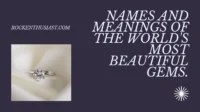Amethyst and citrine are two popular gemstone varieties that belong to the quartz family. Amethyst is known for its stunning purple hues, ranging from pale lilac to deep purple, while citrine exhibits beautiful shades of yellow to golden. These gemstones possess unique properties and have been used in jewelry for centuries.
Key Takeaways:
- Amethyst and citrine are both varieties of the quartz family.
- Amethyst is prized for its purple color range, while citrine showcases shades of yellow to golden.
- These gemstones have distinct properties and have been used in jewelry for a long time.
- Amethyst is associated with spirituality, while citrine is known as the “stone of abundance.”
- Both amethyst and citrine make stunning additions to any jewelry collection.
Properties of Amethyst
Amethyst is a captivating gemstone with a range of properties that make it highly sought after in the world of jewelry. Known for its regal purple color, amethyst symbolizes wisdom, strength, and confidence. From pale lilac hues to deep purple shades, amethyst’s color palette is simply mesmerizing.
But what sets amethyst apart is its ability to exhibit reddish or rose overtones, adding an extra dimension to its beauty. The finest amethysts are those with a deep and intense purple color.
Aside from its visual appeal, amethyst is believed to possess both calming and meditative properties. It is said to promote clarity of thought and help in spiritual growth. Amethyst’s serene energy makes it an excellent stone for meditation and mindfulness practices.
In addition to its spiritual properties, amethyst is also the birthstone for February and is associated with the 6th and 17th wedding anniversaries. Its timeless beauty and symbolic significance make it a meaningful and cherished gemstone.
Overall, the properties of amethyst can be summarized as follows:
| Properties of Amethyst | |
|---|---|
| Color | Regal purple, ranging from pale lilac to deep purple |
| Color Overtone | Reddish or rose |
| Symbolism | Wisdom, strength, confidence |
| Calming Properties | Promotes clarity of thought and spiritual growth |
| Birthstone and Anniversaries | February birthstone, 6th and 17th wedding anniversaries |
Amethyst’s captivating beauty combined with its spiritual and symbolic significance makes it a truly remarkable gemstone.
Properties of Citrine
Citrine is a type of quartz that is characterized by its yellow to golden hues. It is known as the “stone of abundance” and is believed to attract wealth, success, and prosperity.
Citrine is associated with the solar plexus chakra, promoting self-confidence, motivation, and creativity. It is also known to impart a sense of joy, warmth, and positivity to its wearer.

| Citrine Properties | |
|---|---|
| Color Range | Yellow to golden |
| Chakra Association | Solar Plexus |
| Symbolism | Abundance, prosperity, joy |
“Citrine is like sunshine captured in a gemstone, radiating warmth, positivity, and abundance.”
Citrine’s vibrant color and uplifting energy make it a popular choice for jewelry enthusiasts. Its golden hues bring a cheerful and sunny vibe to any accessory, be it a necklace, ring, or earrings.
Not only does citrine add a pop of color to your style, but it is also believed to bring luck and good fortune. Its properties align with the intention of attracting abundance and success in various aspects of life.
Uses of Citrine in Jewelry:
- Stunning citrine solitaire rings that make a bold statement
- Delicate citrine pendant necklaces for a touch of elegance
- Sparkling citrine earrings that light up your face
Citrine jewelry is versatile, complementing both casual and formal attire with its warm and vibrant presence. Whether you’re seeking positivity or aiming to bring a little sunshine into your life, citrine is the perfect gemstone to wear and cherish.
Differences Between Amethyst and Citrine
Amethyst and citrine, both varieties of quartz, possess distinct features that set them apart. The primary difference lies in their coloration. Amethyst exhibits captivating purple shades, ranging from pale lilac to deep purple, while citrine displays vibrant shades of yellow and golden hues.
It’s important to note that some citrine in the market is actually amethyst that has undergone heat treatment to alter its color. Natural citrine, on the other hand, is relatively rare.
Despite their differing colors, amethyst and citrine share similar physical characteristics due to their quartz composition. These gemstones are equally durable and offer a captivating appearance that complements a variety of jewelry designs.
Explore the visual contrast between amethyst and citrine:
| Amethyst | Citrine |
|---|---|
| https://www.youtube.com/watch?v=9Em28Mx6Jkk |  |
Geological Origins of Amethyst and Citrine
Amethyst and citrine are fascinating gemstone varieties that have their roots in the Earth’s geological processes. These gemstones can be found in various locations around the world, each with its unique geological characteristics.
Amethyst, with its captivating purple hues, is commonly mined in countries such as Brazil, Uruguay, Bolivia, and Zambia. These regions offer favorable conditions for the formation of amethyst crystals, resulting in a range of stunning purple shades.
In contrast, citrine, known for its vibrant yellow to golden color, is often found in Brazil and other African nations. The geological conditions in these areas create the ideal environment for citrine to develop its distinctive color.
Formation Process
Both amethyst and citrine share a common heritage as varieties of quartz. They are formed within the Earth’s crust through the crystallization of quartz under specific conditions. The precise geological processes responsible for their formation contribute to their unique attributes.
During the crystallization process, various mineral impurities, such as iron, manganese, and other trace elements, become incorporated into the quartz crystal lattice. The presence of these impurities gives amethyst and citrine their characteristic colors.
Amethyst owes its purple hues to the presence of iron impurities, while citrine’s yellow to golden color is attributed to the presence of iron and other trace elements.
| Gemstone Variety | Primary Locations |
|---|---|
| Amethyst | Brazil, Uruguay, Bolivia, Zambia |
| Citrine | Brazil, Africa (various nations) |
Table: Primary Locations of Amethyst and Citrine
As these gemstones form deep within the Earth’s crust, geological forces, such as volcanic activity and tectonic movements, play a crucial role in their creation. These processes expose the gemstones to intense heat and pressure, allowing them to crystallize and develop their distinct characteristics.
The geological origins of amethyst and citrine add to their allure and make them valued additions to any gemstone collection. Their stunning colors and unique properties are a testament to the remarkable natural processes that have taken place over millions of years.
Uses of Amethyst and Citrine
Amethyst and citrine, both popular gemstone varieties, have been cherished for their beauty and properties for centuries. These gemstones have found extensive use in jewelry, thanks to their unique colors and characteristics.
Amethyst:
Amethyst is a versatile gemstone that can be faceted into various cuts, including rounds, ovals, cushions, and emeralds. Its regal purple color adds an elegant touch to rings, necklaces, bracelets, and earrings. Amethyst jewelry is highly sought after for its enchanting beauty and symbolism.
In addition to its use in jewelry, amethyst is also widely used in crystal healing and spiritual practices. Many believe that amethyst possesses metaphysical properties that promote calmness, clarity of thought, and spiritual growth. As a result, it is often used for meditation, stress relief, and promoting a sense of balance and inner peace.
Citrine:

Citrine’s vibrant yellow color makes it a favored choice for jewelry. It is often set in rings, pendants, and earrings, creating stunning pieces that stand out with their warm and joyful tones. Citrine jewelry complements a variety of styles and occasions, adding a touch of sunshine to any ensemble.
November birthstone jewelry often features citrine, making it particularly significant for those born in that month. Another reason for the popularity of citrine is its resemblance to yellow diamonds, offering an alternative option for those seeking a vibrant yellow gemstone.
Both amethyst and citrine are versatile gemstones that can enhance any jewelry collection. Whether you’re drawn to the regal purple of amethyst or the vibrant yellow of citrine, these gemstones offer endless possibilities for creating unique and meaningful pieces.
The History and Mythology of Amethyst
Amethyst holds a rich history and mythology, making it a gemstone of intrigue and fascination. In ancient Greece, this gemstone was believed to possess protective properties against intoxication and drunkenness. Its name even derives from the Greek word “amethystos,” which means “not drunken.” Throughout history, amethyst has been associated with piety, celibacy, and dignity.
According to legend, amethyst has a remarkable origin story. It is said that the Greek god Bacchus, known for wine and revelry, poured his wine over a young maiden named Amethyst to save her from tigers. As the wine touched her, Amethyst was transformed into a crystalline form of quartz, creating the striking purple gemstone we know today.
“Amethyst holds a rich history and mythology, making it a gemstone of intrigue and fascination.”
In addition to its protective qualities, amethyst symbolizes spiritual wisdom and clarity. It has long been regarded as a stone that aids in meditation and promotes a calm mind. Amethyst’s alluring purple hues evoke a sense of royalty and elegance, making it a favorite gemstone for jewelry throughout the ages.
To better understand the history and mythology of amethyst, let’s explore its significance in different cultures and belief systems:
Ancient Egypt
In ancient Egypt, amethyst was highly prized and associated with protection and royalty. It was often used in amulets, jewelry, and burial ornaments, symbolizing power and divine connection.
Roman Empire
The Romans believed amethyst could prevent drunkenness and intoxication. They often wore amethyst-encrusted cups and carved vessels from the stone to enjoy their wine without fear of inebriation.
Christianity
Amethyst has been associated with Christianity for centuries and is often mentioned in religious texts. It is believed to have been one of the twelve gemstones adorning the high priest’s breastplate and represents the apostle Matthias.
Eastern Cultures
In Eastern cultures, amethyst is associated with spiritual enlightenment and balance. It is used for meditation and is believed to align the spiritual and physical realms.
Amethyst’s captivating history and mythology continue to add to its appeal as a cherished gemstone to this day.
**Table: Amethyst in History and Mythology**
| **Culture** | **Symbolism and Beliefs** |
|————-|———————————————————————————————–|
| Ancient Egypt | Associated with protection and royalty. Used in amulets, jewelry, and burial ornaments. |
| Roman Empire | Believed to prevent drunkenness and intoxication. Popular in decorative cups and vessels. |
| Christianity | Associated with the apostle Matthias and mentioned in religious texts. |
| Eastern Cultures | Associated with spiritual enlightenment and used for meditation. |
The Significance of Citrine in Ancient Cultures
Citrine, with its captivating golden hues, has held great significance in various ancient cultures throughout history. This stunning gemstone was often associated with wealth, prosperity, and success, making it highly revered and cherished.
In ancient Greece, citrine was believed to possess special protective properties. It was used as a talisman against snake venom and evil thoughts, providing a shield of safeguarding energy to its wearer. This belief in the protective powers of citrine highlights its importance in ancient Greek culture.
“Citrine was used as a talisman against snake venom and evil thoughts.”
In Hindu mythology, citrine was mentioned when referring to the Kalpa Tree, a mythical tree that bore fruits and leaves made of precious gemstones. Citrine, with its radiant golden hues, symbolized the abundance and prosperity associated with the mythical tree. This symbolism established citrine as a stone of prosperity and affirmed its significance in Hindu culture.
Even today, citrine is still highly cherished for its association with abundance and positivity. It continues to hold deep meaning and is often regarded as a stone that brings success and prosperity to those who wear it.

Popular Cuts and Jewelry Designs for Amethyst and Citrine
Amethyst and citrine, as captivating gemstone varieties, offer a wide range of popular cuts and jewelry designs. These gemstones, known for their unique colors and metaphysical properties, can be fashioned into various exquisite styles to suit different tastes and preferences.
When it comes to cuts, amethyst and citrine can be beautifully faceted in a variety of shapes, including rounds, ovals, cushions, and emeralds. Each cut brings out the gemstones’ inherent beauty and enhances their visual appeal. Whether you prefer the classic brilliance of round cuts or the elegance of emerald cuts, there is a cut that will showcase the captivating colors and properties of amethyst and citrine.
As for jewelry designs, both amethyst and citrine are commonly used in rings, necklaces, earrings, and bracelets. These gemstones lend themselves well to various settings, allowing jewelry designers to create stunning pieces that highlight the unique beauty of each stone. Amethyst and citrine can be featured as solitaire stones, drawing all attention to their captivating colors, or they can be combined with other gemstones for a vibrant and eye-catching design.
Here is a table showcasing popular cuts and jewelry designs for amethyst and citrine.
| Popular Cuts | Jewelry Designs |
|---|---|
| Rounds | Amethyst and citrine rings |
| Ovals | Amethyst and citrine necklaces |
| Cushions | Amethyst and citrine earrings |
| Emeralds | Amethyst and citrine bracelets |
The beautiful cuts and jewelry designs bring out the best in amethyst and citrine, making them sought after gemstones for those seeking unique and meaningful pieces of jewelry. Whether you prefer a classic ring, an elegant necklace, a stunning pair of earrings, or a stylish bracelet, amethyst and citrine offer a plethora of options to suit your style and personality.
Amethyst and Citrine in the Jewelry Market
Amethyst and citrine are highly sought after gemstone varieties in the jewelry market. Their unique colors, affordability, and versatility make them popular choices for both casual and formal accessories. Let’s explore why these gemstones are so popular and how to ensure you’re getting authentic pieces.
Wide Availability and Popularity
Both amethyst and citrine are widely available in the jewelry market, thanks to their abundance and popularity. They are often used as affordable alternatives to other gemstones, offering a wide range of beautiful and vibrant colors.
Amethyst, with its regal purple hues, adds a touch of elegance to any piece of jewelry. Citrine, on the other hand, exudes warmth and radiance with its sunny yellow tones. These gemstones can complement various styles and preferences, making them versatile options for any occasion.
Authenticity and Quality
It’s essential to choose reputable sources when purchasing gemstone jewelry to ensure authenticity and quality. Due to the popularity of citrine, there is a prevalence of amethyst that has been heat-treated to resemble citrine. While both variations are beautiful, it’s crucial to know what you’re buying.
Remember to always ask for a gemstone’s certification or consult with a trusted jeweler who can provide you with detailed information about the gemstone’s authenticity and any treatments it may have undergone.
Comparing Amethyst and Citrine in the Jewelry Market
| Amethyst | Citrine |
|---|---|
| Purple hues ranging from pale lilac to deep purple | Yellow to golden hues |
| Regal and elegant | Warm and radiant |
| Birthstone for February and associated with 6th and 17th wedding anniversaries | November birthstone |
| Calming and meditative properties | “Stone of abundance” attracting wealth and prosperity |
Caring for Your Amethyst and Citrine Jewelry
To ensure the longevity of your amethyst and citrine jewelry, proper care and maintenance are essential. Here are some tips to keep in mind:
- Store your jewelry in a soft pouch or a separate compartment to prevent scratches.
- Avoid exposing your jewelry to harsh chemicals, such as household cleaners or perfumes.
- Clean your amethyst and citrine jewelry using mild soapy water and a soft brush. Rinse thoroughly and pat dry.
- Avoid exposing your jewelry to high heat or sudden temperature changes, as these can cause thermal shock and damage the gemstones.
Incorporate these simple steps into your jewelry care routine to maintain the beauty and luster of your amethyst and citrine pieces for years to come.
Amethyst and citrine jewelry offers a wide range of colors, styles, and meanings. Whether you’re drawn to the regal purple of amethyst or the vibrant yellow of citrine, these gemstone varieties are sure to make a stunning addition to your collection. Remember to choose reputable sources, care for your jewelry properly, and enjoy the timeless beauty of amethyst and citrine for years to come.
Care and Maintenance of Amethyst and Citrine Jewelry
Amethyst and citrine jewelry are precious possessions that require proper care to preserve their beauty and luster. These gemstones, belonging to the quartz family, have a hardness of 7.0 on the Mohs Scale, making them relatively durable. However, they are still susceptible to scratches and damage from harsh chemicals, requiring cautious handling and maintenance.
To keep your amethyst and citrine jewelry in pristine condition, follow these care tips:
- Use a soft brush and mild soapy water to clean your gemstone jewelry. Gently scrub the surface, ensuring you reach all the nooks and crevices. Rinse thoroughly and pat dry with a soft cloth.
- Avoid exposing your amethyst and citrine jewelry to high heat or sudden temperature changes, as this can cause thermal shock and lead to gemstone damage.
- Keep your gemstone jewelry away from harsh chemicals, including household cleaning agents and abrasive substances, as they can dull the gemstones’ brilliance and damage their surfaces.
- When not wearing your amethyst and citrine jewelry, store them separately in a soft pouch or jewelry box to prevent scratching or tangling with other pieces.
- Regularly inspect your gemstone jewelry for loose prongs or settings. If any issues are identified, take your jewelry to a professional jeweler for repairs.
It is important to note that different jewelry designs may have specific care instructions. Always refer to the guidelines provided by the jeweler or manufacturer for the best care practices specific to your amethyst and citrine jewelry.
By following these care and maintenance tips, you can enjoy your amethyst and citrine jewelry for years to come, showcasing their mesmerizing beauty and alluring charm.
The Symbolism and Meaning of Amethyst and Citrine
Amethyst and citrine, two gemstone varieties belonging to the quartz family, hold symbolic meanings that can vary across cultures and beliefs. Both gemstones offer unique properties and are prized for their vibrant colors.
Amethyst is often associated with spirituality, wisdom, clarity, and protection against negative energy. Its regal purple hues symbolize balance and inner peace. Amethyst is believed to enhance spiritual awareness, promote calmness, and aid in meditation. It is considered a stone of enlightenment and is highly valued for its metaphysical properties.
Citrine, on the other hand, symbolizes abundance, wealth, success, and joy. With its warm, golden shades, citrine is thought to attract positive energy, prosperity, and happiness. This gemstone is associated with success in business and personal endeavors. It is believed to bring confidence, motivation, and creativity to its wearer. Citrine is highly regarded for its uplifting and optimistic properties.
The symbolic significance of amethyst and citrine adds to their appeal in jewelry and personal adornment. These gemstones not only showcase unique beauty but also carry deep meanings that resonate with individuals seeking spiritual and emotional well-being.
The mesmerizing color and symbolism of amethyst and citrine make them highly sought after in the world of gemstone varieties. Whether you resonate more with the spiritual tranquility of amethyst or the vibrancy and abundance associated with citrine, both gemstones offer a captivating presence that adds meaning and beauty to any piece of jewelry.
The Rarity and Value of Fine Amethyst and Citrine
Amethyst and citrine are not only esteemed for their beauty but also for their rarity and value. The worth of these gemstone varieties is determined by several factors, including color, clarity, size, and origin. Let’s explore the significance of these elements in assessing the value of amethyst and citrine.
Color:
When it comes to amethyst, deep-colored specimens with minimal color zoning or inclusions are highly sought after. The richest hues of purple command higher prices due to their rarity and captivating appeal.
Citrine, on the other hand, is renowned for its vibrant yellow tones. The more intense and vivid the yellow color, the more valuable the citrine gemstone becomes. Natural citrine is relatively rare compared to amethyst, which adds to its allure and desirability among collectors and jewelry enthusiasts.
Clarity:
The clarity of amethyst and citrine is another crucial factor in determining their value. Gemstones with few to no visible inclusions are considered more valuable as they exhibit higher transparency and brilliance.
Size:
Like other gemstones, size plays a role in the value of amethyst and citrine. Larger specimens are generally priced higher due to their rarity and the amount of rough material required to produce them.
Origin:
The origin of amethyst and citrine can also impact their value. Gemstones that originate from renowned mining locations, such as Brazil, Uruguay, and Zambia for amethyst, or Brazil for citrine, often carry a higher price tag due to their perceived quality and reputation.
| Factors | Influence on Value |
|---|---|
| Color | Deep-colored amethysts and vivid yellow citrines command higher prices due to their rarity and visual appeal. |
| Clarity | Gemstones with minimal inclusions are considered more valuable, as they exhibit higher transparency and brilliance. |
| Size | Larger specimens are generally priced higher due to their rarity and the amount of rough material required to produce them. |
| Origin | Gemstones from renowned mining locations often carry a higher price tag due to their perceived quality and reputation. |
Market prices for fine amethyst and citrine can vary, ranging from affordable options to high-end pieces. It is important to consider these factors when purchasing jewelry featuring these gemstones, as they impact both the cost and the aesthetic appeal of the piece.
Conclusion
Amethyst and citrine are two captivating gemstone varieties that share a common origin in the quartz family. These gemstones offer a stunning array of colors, from the regal purple of amethyst to the vibrant yellow hues of citrine. But their appeal goes beyond their beauty, as they possess unique properties and meanings that have made them cherished gemstones throughout history.
From their ancient mythology and symbolism to their use in modern jewelry, amethyst and citrine continue to captivate and inspire. Amethyst is associated with wisdom, strength, and spirituality, while citrine is known as the “stone of abundance,” attracting wealth and prosperity. Both gemstones hold significant cultural and metaphysical meaning, making them cherished additions to any jewelry collection.
Whether you wear amethyst for its regal elegance or citrine for its joyful energy, both gemstone varieties offer a touch of natural beauty for any occasion. Their versatility and allure make them popular choices for a wide range of jewelry designs, from stunning solitaire pieces to intricate combinations with other gemstones.
Explore the enchanting world of amethyst and citrine and discover the beauty and allure of these quartz varieties. Whether you choose amethyst or citrine, you can adorn yourself with a gemstone that holds a rich history, unique properties, and a touch of natural enchantment.





